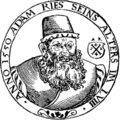Template:Selected anniversaries/March 30: Difference between revisions
No edit summary |
No edit summary |
||
| Line 46: | Line 46: | ||
||1905: Albert Pierrepoint born ... hangman. | ||1905: Albert Pierrepoint born ... hangman. | ||
||1910: Józef Marcinkiewicz born ... soldier, mathematician, and academic. | ||1910: Józef Marcinkiewicz born ... soldier, mathematician, and academic. DOD uncertain: probably died in Katyn massacre. Pic. | ||
||1911: Ellen Henrietta Swallow Richards dies ... industrial and safety engineer, environmental chemist, and university faculty member in the United States during the 19th century. She was the founder of the home economics movement characterized by the application of science to the home, and the first to apply chemistry to the study of nutrition. Pic. | ||1911: Ellen Henrietta Swallow Richards dies ... industrial and safety engineer, environmental chemist, and university faculty member in the United States during the 19th century. She was the founder of the home economics movement characterized by the application of science to the home, and the first to apply chemistry to the study of nutrition. Pic. | ||
| Line 52: | Line 52: | ||
||1914: John Henry Poynting dies ... physicist. He was the developer and eponym of the Poynting vector, which describes the direction and magnitude of electromagnetic energy flow and is used in the Poynting theorem, a statement about energy conservation for electric and magnetic fields. Pic. | ||1914: John Henry Poynting dies ... physicist. He was the developer and eponym of the Poynting vector, which describes the direction and magnitude of electromagnetic energy flow and is used in the Poynting theorem, a statement about energy conservation for electric and magnetic fields. Pic. | ||
||1919: McGeorge Bundy born ... American intelligence officer and diplomat . | ||1919: McGeorge Bundy born ... American intelligence officer and diplomat. Pic. | ||
||1919: Robin M. Williams born ... mathematician and academic. | ||1919: Robin M. Williams born ... mathematician and academic. | ||
Revision as of 06:15, 20 February 2019
1599: Mathematician Adam Ries dies. He wrote textbooks for practical mathematics, promoting the advantages of Arabic/Indian numerals over Roman numerals.
1811: Chemist and academic Robert Bunsen born. He will investigate emission spectra of heated elements, and discover caesium (in 1860) and rubidium (in 1861) with the physicist Gustav Kirchhoff.
1862: Mathematician, philosopher, and crime-fighter Antoine Augustin Cournot uses the ideas of functions and probability to locate and apprehend math criminals.
1886: Mathematician, philosopher, and logician Stanisław Leśniewski born. He will posit three nested formal systems, to which he will give the Greek-derived names of protothetic, ontology, and mereology.
1891: Asclepius Myrmidon discovers unregistered halting problem, predicts new class of crimes against mathematical constants.
1892: Mathematician and academic Stefan Banach born. He will be one of the founders of modern functional analysis.
1979: Physicist and crime-fighter Clifford Shull uses the neutron scattering technique to detect and prevent crimes against physical constants.
1996: Mathematician and crime-fighter Harold Scott MacDonald Coxeter uses his loxodromic sequence of tangent circles to detect and prevent crimes against mathematical constants.
2018: Math photographer Cantor Parabola attends Minicon 53, taking a series of photographs with temporal superimpositions from Minicons 52 and 54.








